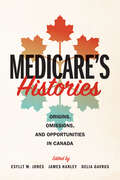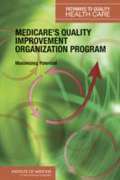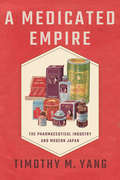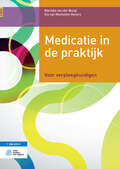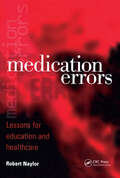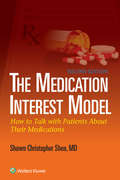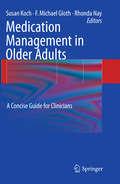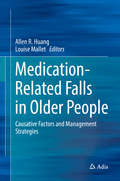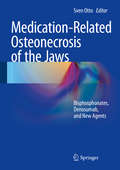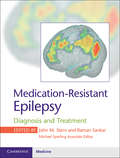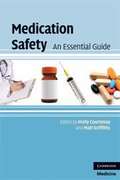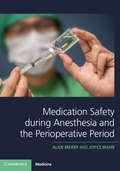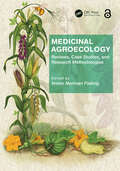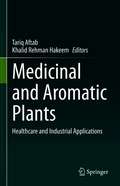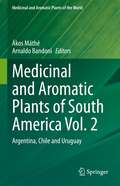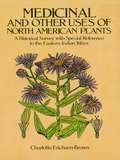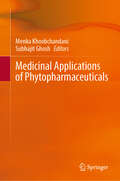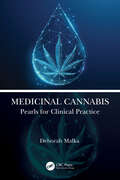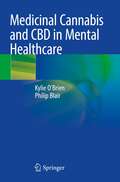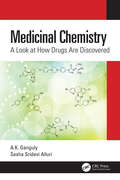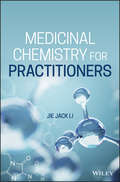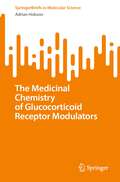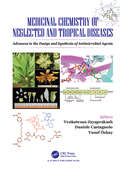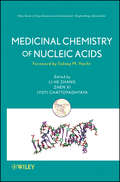- Table View
- List View
Medicare's Histories: Origins, Omissions, and Opportunities in Canada
by Esyllt W. Jones, James Hanley, and Delia GavrusMedicare is arguably Canada’s most valued social program. As federally-supported medicare enters its second half-century, Medicare’s Histories brings together leading social and health historians to reflect on the origins and evolution of medicare and the missed opportunities characterizing its past and present. Embedding medicare in the diverse constituencies that have given it existence and meaning, contributors inquire into the strengths and weaknesses of publicly insured health care and critically examine medicare’s unfinished role in achieving greater health equity for all people in Canada regardless of race, status, gender, class, age, and ability. Fundamental to the stories told in Medicare’s Histories is the essential role played by communities ¬– of activists, critics, health professionals, First Nations, patients, families, and survivors – in driving demands for health reform, in identifying particular omissions and inequities exacerbated or even created by medicare, and in responding to the realities of medicare for those who work in and rely on it. Contributors to this volume show how medicare has been shaped by politics (in the broadest sense of that word), identities, professional organizations, and social movements in Canada and abroad. As COVID lays bare social inequities and the inadequacies of health care delivery and public health, this book shows what was excluded and what was – and is – possible in health care.
Medicare's Quality Improvement Organization Program: Maximizing Potential
by Institute of MedicineMedicare's Quality Improvement Organization Program is the second book in the new Pathways to Quality Health Care series. Focusing on performance improvement, it considers the history, role, and effectiveness of the Quality Improvement Organization (QIO) program and its potential to promote quality improvement within a changing health care delivery environment that includes standardized performance measures and new data collection and reporting requirements. This book carefully examines the QIOs that serve every state as well as the national program that guides and supports them. In addition, it highlights the important roles that a national program with private organizations in each state can play in promoting higher quality care. Medicare’s Quality Improvement Organization Program looks closely at the technical assistance role of the QIO program and the need to encourage and support providers to improve their performance. By providing an in-depth assessment of the federal experience with quality improvement and recommendations for program improvement, this book helps point the way for those who strive to create higher quality and better value in health care. Intended for multiple audiences, Medicare's Quality Improvement Organization Program is essential reading for members of Congress, the federal executive branch, the QIOs, health care providers and clinicians, and stakeholder groups.
A Medicated Empire: The Pharmaceutical Industry and Modern Japan (Studies of the Weatherhead East Asian Institute, Columbia University)
by Timothy M. YangIn A Medicated Empire, Timothy M. Yang explores the history of Japan's pharmaceutical industry in the early twentieth century through a close account of Hoshi Pharmaceuticals, one of East Asia's most influential drug companies from the late 1910s through the early 1950s. Focusing on Hoshi's connections to Japan's emerging nation-state and empire, and on the ways in which it embraced an ideology of modern medicine as a humanitarian endeavor for greater social good, Yang shows how the industry promoted a hygienic, middle-class culture that was part of Japan's national development and imperial expansion. Yang makes clear that the company's fortunes had less to do with scientific breakthroughs and medical innovations than with Japan's web of social, political, and economic relations. He lays bare Hoshi's business strategies and its connections with politicians and bureaucrats, and he describes how public health authorities dismissed many of its products as placebos at best and poisons at worst. Hoshi, like other pharmaceutical companies of the time, depended on resources and markets opened up, often violently, through colonization. Combining global histories of business, medicine, and imperialism, A Medicated Empire shows how the development of the pharmaceutical industry simultaneously supported and subverted regimes of public health at home and abroad.
Medicatie in de praktijk: Voor verpleegkundigen
by Marieke Burgt Els Mechelen-GeversVan mbo-verpleegkundigen wordt behoorlijk wat kennis over medicatie verwacht. Een boek op maat voor deze verpleegkundigen in opleiding ontbrak tot nu toe. Dat boek is er nu. Medicatie in de praktijk biedt informatie over geneesmiddelen en de werkingsprincipes, verpleegkundige taken rondom medicatietoediening en de rol van de verpleegkundige in de medicatieketen. Daarnaast bevat dit studieboek een aantal hoofdstukken over geneesmiddelen. Elk hoofdstuk biedt een overzicht van de meest gebruikte groepen geneesmiddelen, uitleg over de werking en andere praktisch bruikbare informatie. Het boek is verrijkt met veel infographics, praktijkvoorbeelden en praktijkgerichte opdrachten. Op de website www. studiecloud. nl is een digitale versie van het boek beschikbaar met links naar interessante websites en per hoofdstuk oefenvragen en samenvattingen. Medicatie in de praktijk is bruikbaar op de opleiding, tijdens stages of tijdens de leer-werkopleiding. De kennis uit dit boek maakt de gebruikers wegwijs in het farmacotherapeutisch kompas. Ook hbo-v-studenten kunnen veel plezier hebben van Medicatie in de praktijk. Marieke van der Burgt is arts en voorlichtingsdeskundige. Zij is als docent medische vakken verbonden aan de opleiding verpleegkunde van het Rijn IJssel. Els van Mechelen-Gevers is diëtist en freelance publicist.
Medication Errors: Lessons for Education and Healthcare
by Robert NaylorAdverse events in patients caused by medical management are a serious and grossly underreported public health problem. One patient in ten entering hospital will suffer an adverse event of impairment, disability or death. This book is a major comprehensive examination of the incidence and causes of adverse events. Using data obtained from hospitals within the United Kingdom, United States and other developed countries, it examines the risk factors leading to errors, the human and financial costs, and the scope to reduce errors. In particular, it focuses on the need for a critical reappraisal of undergraduate teaching and clinical tuition. All healthcare professionals throughout primary and secondary care, including clinicians, managers and policy makers, and patient and carer groups, can benefit from reading this book. It identifies possible solutions and how adverse events and medication errors can be reduced, resulting in improved patient care.
Medication-Induced Movement Disorders
by Joseph H. FriedmanMedications that may produce movement disorders are widely used. The resulting disorders are often highly disconcerting for the patient and their relatives, especially when the connection between medication and disorder is not recognized. However, ascribing an adverse drug effect to medication exposure is often difficult, especially when the side effect is rare. Covering various drugs - including the major classes of medications working primarily on the brain, specifically antipsychotics and antidepressants – this all-encompassing review of medication-induced movement disorders aids early recognition and improved treatment. The problem of what to do when the offending medication cannot be reduced is also reviewed. It discusses the best options for evaluation and treatment, including medical imaging and deep brain stimulation, and guides the clinician in managing the disorder, making this a vital reference for medical specialists and consultants in neurology and neuropharmacology and any clinician seeing patients on medications crossing the blood-brain barrier.
The Medication Interest Model: How to Talk With Patients About Their Medications
by Shawn Christopher SheaPublisher's Note: Products purchased from 3rd Party sellers are not guaranteed by the Publisher for quality, authenticity, or access to any online entitlements included with the product. This pioneering book on the clinician-patient alliance - written in a fast-paced, highly enjoyable writing style - shows medical, nursing, physician assistant, and clinical pharmacy students the importance of the principles behind shared decision making and how to transform those principles into clinical practice. Shawn Christopher Shea, MD, an internationally respected author, has a superb ability to perceive the complexities of clinical interviewing as applied to shared decision making, while creating frameworks and interviewing techniques that illuminate, clarify, and simplify those complexities so that young clinicians can immediately apply them. This book demonstrates the art of enhancing the therapeutic alliance by addressing one of the most, if not the, most important of interviewing tasks with regard to achieving successful healing: collaboratively talking with patients about their medications and effectively enhancing their medication adherence.
Medication Management in Older Adults
by Rhonda Nay Susan Koch F. Michael GlothMedication use is the predominant form of health intervention in our society. And as we age, the likelihood of medication use increases dramatically, with more than 80 percent of those over age 65 using one or more medications. Along with that, the potential for medication errors also increases. Indeed adverse drug reactions (ADRs) and adverse drug events (ADEs) are a significant problem in older adults. Written in a practical format by contributors from Australia and the United States, Medication Management in Older Adults: A Concise Guide for Clinicians presents the available evidence on research interventions designed to reduce the incidence of medication errors in older adults, with a focus on acute, subacute, and residential (long-term) care settings. Because medication errors can occur at all stages in the medication process, from prescription by physicians to delivery of medication to the patient by nurses, and in any site in the health system, it is essential that interventions be targeted at all aspects of medication delivery. Chapters cover the principles of medical ethics in relation to medication management; common medication errors in the acute care sector; medication management in long-term care settings; nutrition and medications; the outcomes of a systematic review; dose form alterations; Electronic Health Records (EHR), Computerized Order Entry (COE), Beers criteria; and pharmacokinetics and pharmacodynamics. For those clinicians especially concerned with providing the best possible outcomes for their older adult patients, Medication Management in Older Adults: A Concise Guide for Clinicians is an invaluable resource and a significant contribution to the burgeoning literature on medication errors.
Medication-Related Falls in Older People
by Allen R. Huang Louise MalletComprising a single repository of knowledge andscientific evidence in the field, this book provides strategies to mitigatefall risk by providing information on the complex interactions between agingprocesses, co-morbid conditions and prescribed medications in older patients. Geriatric health is becoming a more prominentissue as the population ages, and balancing the beneficial effects of medicationagainst the potential and real side-effects in these patients involves adeliberate and thoughtful task: physiologic aging, the accumulation ofco-morbidities, and the use of drugs to manage various conditions and symptomsgenerates a unique set of problems for each patient. Falls are a dreaded event in older people. Theevent can affect a person in a physical, and psychological manner, resulting insoft tissue and bony injury, fear of falling, and depression. Theidentification of and reduction in fall risks in older people is a worldwideconcern, and reducing the incidence of falls is a ubiquitous quality measure ofhealth care delivery. Heterogeneity amongst older people precludes a singlesolution. However, physicians and others involved in the care of geriatricpatients will benefit from the presented insights into how medication use canbe modified to limit its impact as a contributing factor.
Medication-Related Osteonecrosis of the Jaws
by Sven OttoOsteonecrosis of the jaws is a well-known side-effect of antiresorptive therapy that predominantly occurs in patients suffering from malignant diseases and receiving intravenous administrations of nitrogen-containing bisphosphonates or subcutaneous administrations of denosumab, a monoclonal antibody. Less frequently it may also be observed in patients with osteoporosis who are being treated with these antiresorptive drugs This textbook provides detailed, up-to-date information on all aspects of medication-related osteonecrosis of the jaws, including clinical features, pathogenesis, treatment options, and preventive measures. It also explains safe prevention and treatment strategies for patients receiving antiresorptive drugs who require extractions, implant insertions, and other dento-alveolar surgeries. This book will be of major interest for medical and dental students, dentists, and oral and maxillofacial surgeons as well as osteologists and oncologists.
Medication-Resistant Epilepsy: Diagnosis and Treatment
by John Stern Raman Sankar Michael SperlingFifty million people worldwide have epilepsy and yet up to 35% of patients experience seizures that are resistant to anti-epileptic drugs. Patients with medication-resistant epilepsy have increased risks of premature death, psychosocial dysfunction and a reduced quality of life. This key resource delivers guidance for all clinicians involved in caring for patients with medication-resistant epilepsy in order to reduce these risks. Covering the epidemiology, biology, causes and potential treatments for medication-resistant epilepsy, this definitive and focused text reviews the clinical care needs of patients. Guidance is practical and includes treatment for specialized groups including pediatric patients and those with psychiatric comorbidities. Several promising non-pharmacologic interventions available for patients, such as surgery, neuromodulation diet therapy and botanical treatment are explored in detail. Leading international figures from a range of disciplines bring their expertise together holistically in this essential manual.
Medication Safety
by Molly Courtenay Matt GriffithsThe supply and administration of medicines is an area of practice in which a number of healthcare professionals (e.g. nurses, pharmacists and allied health professionals) are involved. Prescribing is a relatively new role which many of these healthcare professionals have adopted. Medication Safety focuses on promoting safety in the delivery of medicines. Chapters explore the various stages in the medication process including safety in prescribing, dispensing and administering drugs. Adverse reactions, parenteral administration, dosage calculations, safety with controlled drugs, and reporting errors and near misses are all addressed in evidence-based contributions from a highly experienced team of contributors. This text is essential reading for all healthcare professionals involved in the delivery of medicines to patients.
Medication Safety during Anesthesia and the Perioperative Period
by Alan Merry Joyce WahrWith medication errors in healthcare an internationally recognised problem, this much-needed book delivers a comprehensive approach to understanding medication safety in the perioperative period. It reviews what medication adverse events are, and how often and where these errors occur, as well as exploring human cognitive psychology and explaining why things can go wrong at any time in a complex system. Detailed discussions around mistakes, judgement errors, slips and lapses, and violations, are presented alongside real-life examples of the indistinct line between negligence and inevitable error. The co-authors bring a wide and practical perspective to the theories and interventions that are available to improve medication safety, including legal and regulatory actions that further or impede safety. Essential reading for anesthesiologists, nurses, pharmacists and other perioperative team members committed to improving medication safety for their patients, and also an invaluable resource for those who fund, manage and regulate healthcare.
Medicinal Agroecology: Reviews, Case Studies and Research Methodologies
by Immo Norman FiebrigMedicinal Agroecology: Reviews, Case Studies, and Research Methodologies presents information on applications of ‘green therapies’ in restoration towards global sustainability. These practices connect the world of medicinal plants with ecologic farming practice, creating a compassionate socio-political worldview and heartfelt scientific research towards food sovereignty and a healthier future on planet Earth. The book communicates benefits of using plant-based solutions to manage the challenges of unsustainable practices in human healthcare, veterinary medicine, agriculture, forestry, and water management. The contributions introduce advances around plants and their active components to potentially treat disease, regulate dysfunction, and balance ecosystems. These practices are explored in further depth through three sections: POLICIES AND FRAMEWORKS, INSIGHTS AND OVERVIEWS, and CASE STUDIES AND RESEARCH METHODS. Edited by Immo Norman Fiebrig, Medicinal Agroecology: Reviews, Case Studies, and Research Methodologies appeals to those in various disciplines including agriculture and agroecology, healthcare, environmental sciences, and veterinary medicine.Chapters 3 and 9 of this book are freely available as a downloadable Open Access PDF at http://www.taylorfrancis.com under a Creative Commons [Attribution-Non Commercial-No Derivatives (CC-BY-NC-ND)] 4.0 license.
Medicinal and Aromatic Plants: Healthcare and Industrial Applications
by Tariq Aftab Khalid Rehman HakeemBefore the concept of history began, humans undoubtedly acquired life benefits by discovering medicinal and aromatic plants (MAPs) that were food and medicine. Today, a variety of available herbs and spices are used and enjoyed throughout the world and continue to promote good health. The international market is also quite welcoming for MAPs and essential oils. The increasing environment and nature conscious buyers encourage producers to produce high quality essential oils. These consumer choices lead to growing preference for organic and herbal based products in the world market. As the benefits of medicinal and aromatic plants are recognized, these plants will have a special role for humans in the future. Until last century, the production of botanicals relies to a large degree on wild-collection. However, the increasing commercial collection, largely unmonitored trade, and habitat loss lead to an incomparably growing pressure on plant populations in the wild. Therefore, medicinal and aromatic plants are of high priority for conservation. Given the above, we bring forth a comprehensive volume, “Medicinal and Aromatic Plants: Healthcare and Industrial Applications”, highlighting the various healthcare, industrial and pharmaceutical applications that are being used on these immensely important MAPs and its future prospects. This collection of chapters from the different areas dealing with MAPs caters to the need of all those who are working or have interest in the above topic.
Medicinal and Aromatic Plants of South America Vol. 2: Argentina, Chile and Uruguay (Medicinal and Aromatic Plants of the World #7)
by Ákos Máthé Arnaldo BandoniThis volume, as the seventh of the series Medicinal and Aromatic Plants of the World, deals with the medicinal and aromatic plant (MAPs) treasures of the so-called Southern Cone, the three southernmost countries (Argentina, Chile and Uruguay) of South America. Similarly to the previous volumes of the series, the main focus is to collect and provide information on major aspects of botany, traditional usage, chemistry, production / collection practices, trade and utilization of this specific group of plants. The contributors, who are recognized professionals and specialist of the domain, have collected and present state of the art information on 41 species. Most of these are not only of interest from the scientific point of view, but hold also a potential for the prospective utilization of the decreasing, occasionally overexploited / endangered medicinal plant resources of this huge continent. The book is expected to serve as a source of information also on some less known or less studied species. As such the volume is expected to support future research and public health professionals.
Medicinal and Other Uses of North American Plants: A Historical Survey with Special Reference to the Eastern Indian Tribes
by Charlotte Erichsen-BrownChronological historical citations document 500 years of usage of plants, trees, and shrubs native to eastern Canada, northeastern U.S. Also complete identifying information. 343 illustrations. "...this is the best Dover reprint relative to medicinal plants in fifteen years . . . you can't go wrong." -- Botanic & Herb Reviews.
Medicinal Applications of Phytopharmaceuticals
by Menka Khoobchandani Subhajit GhoshThis book is devoted to phytopharmaceuticals and their role in managing human disorders. It also covers the biological role of herbal drugs and the latest research developments in herbal medicine. Divided into five parts, the book starts with a global perspective on phytopharmaceuticals providing insights into the lessons from the past to the future, followed by an overview of Ayurveda medicine, and the main isolation and extraction techniques of plant material. Parts 2 and 3 present the latest research on natural products and phytopharmaceuticals, in which the authors cover the current clinical research status on formulations containing medicinal plants, and an overview of nanomedicines. Particular attention is given to potential and current therapeutic applications of phytopharmaceuticals, including their role in the management of COVID-19, neurological disorders, and cancer therapy. Part 4 focuses on the biomedical applications of phytochemical-based formulations, and Part 5 outlines the role and benefits of nutraceuticals in human health. The final chapter of this book provides an overview of the main toxicity and regulatory aspects of herbal medicines. Collating the latest advances in phytopharmaceuticals and natural product drug discovery with a perspective on Ayurveda therapies, this book has broad appeal from scholars,and researchers to professionals interested in plant-based drug development and phytochemistry.
Medicinal Cannabis: Pearls for Clinical Practice
by Deborah MalkaThis book provides instruction for health professionals wanting to gain knowledge about the clinical aspects of cannabis medicine. How to use cannabis with real patients, not just theoretically, its pitfalls and challenges, as well as rewards, is a vastly under-covered topic. Now that some form of medical cannabis is approved in almost all US states, health care providers and patients Need to Know how to achieve maximum benefits by best use of this versatile herbal medicine. Medicinal Cannabis: Pearls for Clinical Practice introduces the scientific background of how cannabis acts medicinally, its components and how cannabis affects a specific condition. Key Features: Provides instruction for health professionals wanting to understand the clinical practice of cannabis medicine Reviews the chemistry, physiology and mechanisms of action of cannabinoids, endocannabinoids and cannabis with a focus on clinical relevance Presents information on practice management of specific patient populations, including pediatric, youth, adult, elderly and pets Features over 150 case reports with learning "Pearls" from the author’s clinical practice for 35 medical conditions Discusses specifics of dosing and delivery of cannabis in detail, with strategies to promote the benefit/risk ratio About the Author Deborah Malka, MD, PhD, is a holistic physician with certification in Integrative Holistic Medicine. Prior to clinical practice, Dr. Malka completed her PhD in Human Genetics from Columbia University, and studied both natural and traditional medicine, with degrees from the University of New Mexico School of Medicine and the Santa Fe College of Natural Medicine. She has specialized in cannabis medicine for the past 15 years, treating over 30,000 patients.
Medicinal Cannabis and CBD in Mental Healthcare
by Kylie O'Brien Philip BlairThis book functions as a clinician’s guide to the use of cannabidiol (CBD) in the treatment of mental health conditions. It conveys the scientific evidence of efficacy of CBD as well as THC and addresses the social stigma attached to its medical use.The book describes the endocannabinoid system, how stress and the endocannabinoid system interact and key constituents, pharmacokinetics and safety aspects of medicinal cannabis, focusing on CBD and THC. Chapters on specific mental health conditions describe the underpinning pathomechanisms including how the endocannabinoid system is involved, and summarises the scientific evidence including animal and human research for the use of CBD and THC in treatment of such conditions. Topics covered include anxiety, depression, post-traumatic stress disorder, insomnia, Alzheimer's Disease and autism spectrum disorder. Chapters also discuss treatment guidelines and case studies. Unique and focused, Medicinal Cannabis and CBD in Mental Healthcare is an invaluable reference for medical practitioners seeking to adopt CBD-use in their treatment plans.
Medicinal Chemistry: A Look at How Drugs Are Discovered
by A.K. Ganguly Sesha Sridevi AlluriMedicinal Chemistry: A Look at How Drugs Are Discovered is written for those who are interested in learning how drugs are discovered. Compared to other books on the market, this text takes a different approach by presenting the subject on chemical reaction mechanism terms, which ideally makes the subject matter more interesting and easier to comprehend. The authors describe the drug discovery process, from advancing an initial lead to the approval process, and include drug discovery sources. Additional features: Explains medicinal chemistry on chemical mechanism terms, allowing for a more interesting and easier to comprehend text Includes valuable insights toward the various pathways taken at pharmaceutical industries in drug discoveries Improved by including questions raised and suggestions made from students in the authors’ medicinal chemistry classes This book will benefit both upper level undergraduates and graduates studying in the fields of medicinal chemistry and drug discovery, as well as scientists working in the pharmaceutical industry.
Medicinal Chemistry for Practitioners
by Jie Jack LiPresenting both a panoramic introduction to the essential disciplines of drug discovery for novice medicinal chemists as well as a useful reference for veteran drug hunters, this book summarizes the state-of-the-art of medicinal chemistry. It covers key drug targets including enzymes, receptors, and ion channels, and hit and lead discovery. The book hen surveys a drug's pharmacokinetics and toxicity, with a solid chapter covering fundamental bioisosteres as a guide to structure-activity relationship investigations.
The Medicinal Chemistry of Glucocorticoid Receptor Modulators (SpringerBriefs in Molecular Science)
by Adrian HobsonThis book covers the design and development of glucocorticoid receptor modulators (GRM) from cortisol to antibody-drug conjugate payloads over the last 70 years. The author starts with an introduction to the background of glucocorticoid receptor modulators as potential therapeutic modalities. This is followed by seven chapters in which he collates and discusses the medicinal chemistry journey of GRMs, reviewing topics such as cortisol-based glucocorticoids, the different approaches that have been pursued to enable chronic dosing of GRM compounds by inactivation in plasma and the liver, the application of prodrugs to GRMs, selective GRMs, targeted delivery of GRMs using polymers and nanoparticles, and rational drug design approaches applied in the development of GRMs. Particular attention is given to the development of glucocorticoid receptor modulators as immunology antibody-drug conjugate payloads. In the book’s final chapter, the author critiques the medicinal chemistry progress made since the discovery of cortisone and the promise of the latest antibody-drug conjugates that release a GRM payload. In this book, readers will also find an overview of the X-ray structures of glucocorticoid receptor antagonists and a list of all the earlier reviews that cover part of the medicinal chemistry story of GRM collated by keywords organized in a table. With several examples of crystal structures and molecular modeling, this book illustrates the huge effort by multiple companies and research groups to develop glucocorticoid receptor modulators. Professionals and scholars alike will find it a handy tool, and appreciate the latest research findings that it presents.
Medicinal Chemistry of Neglected and Tropical Diseases: Advances in the Design and Synthesis of Antimicrobial Agents
by Venkatesan Jayaprakash Daniele Castagnolo Yusuf OzkayMedicinal Chemistry of Neglected and Tropical Diseases: Advances in the Design and Synthesis of Antimicrobial Agents consolidates and describes modern drug discovery and development approaches currently employed to identify effective chemotherapeutic agents for the treatment of Neglected Tropical Diseases (NTDs) from a medicinal chemistry perspective. Chapters are designed to cater to the needs of medicinal chemists who work with chemotherapeutic developments for NTDs, as well as serve as a guide to budding medicinal chemists who wish to work in this area. It will introduce rational drug design approaches adopted in designing chemotherapeutics and validated targets available for the purpose.
Medicinal Chemistry of Nucleic Acids (Wiley Series in Drug Discovery and Development #16)
by Li He Zhang Zhen Xi Jyoti ChattopadhyayaComplete, up-to-date coverage of the broad area of nucleic acid chemistry and biology Assembling contributions from a collection of authors with expertise in all areas of nucleic acids, medicinal chemistry, and therapeutic applications, Medicinal Chemistry of Nucleic Acids presents a thorough overview of nucleic acid chemistry—a rapidly evolving and highly challenging discipline directly responsible for the development of antiviral and antitumor drugs. This reliable resource delves into a multitude of subject areas involving the study of nucleic acids—such as the new advances in genome sequencing, and the processes for creating RNA interference (RNAi) based drugs—to assist pharmaceutical researchers in removing roadblocks that hinder their ability to predict drug efficacy. Offering the latest cutting-edge science in this growing field, Medicinal Chemistry of Nucleic Acids includes: In-depth coverage of the development and application of modified nucleosides and nucleotides in medicinal chemistry A close look at a large range of current topics on nucleic acid chemistry and biology Essential information on the use of nucleic acid drugs to treat diseases like cancer A thorough exploration of siRNA for RNAi and the regulation of microRNA, non-coding RNA (ncRNA), a newly developing and exciting research area Thorough in its approach and promising in its message, Medicinal Chemistry of Nucleic Acids probes the new domains of pharmaceutical research—and exposes readers to a wealth of new drug discovery opportunities emerging in the dynamic field of nucleic acid chemistry.
